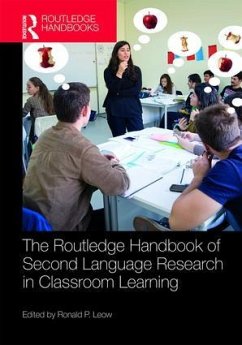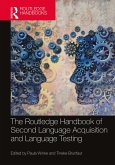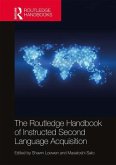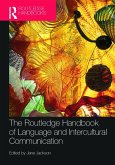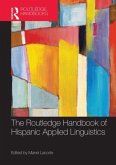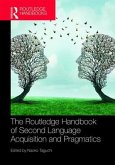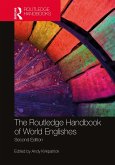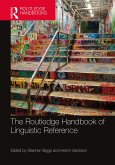The Routledge Handbook of Second Language Research in Classroom Learning
Herausgeber: Leow, Ronald P.
The Routledge Handbook of Second Language Research in Classroom Learning
Herausgeber: Leow, Ronald P.
- Gebundenes Buch
- Merkliste
- Auf die Merkliste
- Bewerten Bewerten
- Teilen
- Produkt teilen
- Produkterinnerung
- Produkterinnerung
The Routledge Handbook of Second Language Research in Classroom Learning is a comprehensive psycholinguistic approach to the issue of instructed language learning that focuses on conceptual replications/extensions of and new research on classroom learning or Instructed SLA (ISLA).
Andere Kunden interessierten sich auch für
![The Routledge Handbook of Second Language Acquisition and Language Testing The Routledge Handbook of Second Language Acquisition and Language Testing]() The Routledge Handbook of Second Language Acquisition and Language Testing300,99 €
The Routledge Handbook of Second Language Acquisition and Language Testing300,99 €![The Routledge Handbook of Instructed Second Language Acquisition The Routledge Handbook of Instructed Second Language Acquisition]() The Routledge Handbook of Instructed Second Language Acquisition315,99 €
The Routledge Handbook of Instructed Second Language Acquisition315,99 €![The Routledge Handbook of Language and Intercultural Communication The Routledge Handbook of Language and Intercultural Communication]() The Routledge Handbook of Language and Intercultural Communication95,99 €
The Routledge Handbook of Language and Intercultural Communication95,99 €![The Routledge Handbook of Hispanic Applied Linguistics The Routledge Handbook of Hispanic Applied Linguistics]() The Routledge Handbook of Hispanic Applied Linguistics311,99 €
The Routledge Handbook of Hispanic Applied Linguistics311,99 €![The Routledge Handbook of Second Language Acquisition and Pragmatics The Routledge Handbook of Second Language Acquisition and Pragmatics]() The Routledge Handbook of Second Language Acquisition and Pragmatics300,99 €
The Routledge Handbook of Second Language Acquisition and Pragmatics300,99 €![The Routledge Handbook of World Englishes The Routledge Handbook of World Englishes]() The Routledge Handbook of World Englishes315,99 €
The Routledge Handbook of World Englishes315,99 €![The Routledge Handbook of Linguistic Reference The Routledge Handbook of Linguistic Reference]() The Routledge Handbook of Linguistic Reference300,99 €
The Routledge Handbook of Linguistic Reference300,99 €-
-
-
The Routledge Handbook of Second Language Research in Classroom Learning is a comprehensive psycholinguistic approach to the issue of instructed language learning that focuses on conceptual replications/extensions of and new research on classroom learning or Instructed SLA (ISLA).
Hinweis: Dieser Artikel kann nur an eine deutsche Lieferadresse ausgeliefert werden.
Hinweis: Dieser Artikel kann nur an eine deutsche Lieferadresse ausgeliefert werden.
Produktdetails
- Produktdetails
- Verlag: Routledge
- Seitenzahl: 518
- Erscheinungstermin: 25. Februar 2019
- Englisch
- Abmessung: 260mm x 183mm x 32mm
- Gewicht: 1159g
- ISBN-13: 9781138056923
- ISBN-10: 1138056928
- Artikelnr.: 55364179
- Herstellerkennzeichnung
- Libri GmbH
- Europaallee 1
- 36244 Bad Hersfeld
- gpsr@libri.de
- Verlag: Routledge
- Seitenzahl: 518
- Erscheinungstermin: 25. Februar 2019
- Englisch
- Abmessung: 260mm x 183mm x 32mm
- Gewicht: 1159g
- ISBN-13: 9781138056923
- ISBN-10: 1138056928
- Artikelnr.: 55364179
- Herstellerkennzeichnung
- Libri GmbH
- Europaallee 1
- 36244 Bad Hersfeld
- gpsr@libri.de
Ronald P. Leow is Professor of Applied Linguistics and Director of Spanish Language Instruction in the Department of Spanish and Portuguese at Georgetown University, USA.
TABLE OF CONTENTS
List of Figures
List of Tables
List of Contributors
1. Classroom learning: Of processing and processes
Ronald P. Leow
Part 1
Theoretical Foundations
2. Theoretical underpinnings and cognitive processes in instructed SLA
Ronald P. Leow
Part II
Research Methodology
3. Verbal reports in instructed SLA research: Opportunities, challenges,
and limitations
Melissa A. Bowles
4. Investigating instructed second language acquisition using L2 learners'
eye-tracking data
Aline Godfroid
Part III
Empirical Studies in ISLA
Testing different stages of the L2 learning process
5. Levels of intake: A preliminary look at intake and eye fixation measures
vis-à-vis type of linguistic item
Anne Thinglum
6. Levels of awareness, depth of processing, and the learning of L2 case
markings
John Rogers
7. Exploring the relationships between lexical prior knowledge and depth of
processing during the intake processing stage: An online investigation of
L2 vocabulary learning
Anne Thinglum, Ellen J. Serafini, and Ronald P. Leow
8. Chapter 8. The role of prior knowledge in depth of processing during
written production: A preliminary investigationJoara Martin Bergsleithner
Appendix A: Explicit Instruction
Appendix B
Appendix C: Narrative Instruction
Appendix D: Pretest and Post-test Using same Task and Test
Feedback
9. Computerized type of feedback and depth of processing during a
computerized problem-solving taskHui-Chen Hsieh
Appendix A
Appendix B
10. Type of feedback and assessment task modality: The role of depth of
processing
Nina Moreno
Appendix A: [+EF] Condition
Appendix B: [-EF] Condition
11. Recasts in SCMC: Replicating and extending Gurzynski-Weiss et al.
(2016)
Chrissy Bistline-Bonilla, Gabriela DeRobles, and Yiran Xu
12. What do learners notice while processing written corrective feedback? A
look at depth of processing via written languaging
Lourdes Cerezo, Rosa M. Manchón, and Florentina Nicolás-Conesa
13. Written corrective feedback in compositions and the role of depth of
processing
Allison Caras
14. Reactivity, language of think aloud protocol, and depth of processing
in the processing of reformulated feedback
Sergio Adrada-Rafael and Marisa Filgueras-Gómez
Appendix A
15. Learners' use of indirect written corrective feedback: Depth of
processing and self-correction
Eun Sung Park and Ok Yeon Kim
16. Teacher and student perspectives of LREs in a Year 1 Spanish class: A
stimulated recall study
Shawn Loewen
Vocabulary learning
17. Sentence-level processing for content and new L2 words: Where does
deeper processing go?
Joe Barcroft
Appendix: Examples of Sentences and Comprehension Checks From the Learning
Phase
18. Test-enhanced learning in L2 Spanish lexical development: Issues of
depth of processing and think-aloud reactivity
Almitra Medina
19. Effects of crosslinguistic similarity, complexity, and depth of
processing on vocabulary recall
Scott Jarvis, Torri Raines, Paula Schaefer, and Olga Sormaz
20. Cognitive load, attention and incidental vocabulary learning: An
eye-tracking study
Haemoon Lee and Hyunhye Choi
Appendix A: A Sample Reading Passage
Appendix B: Test Instrument (Sample Questions)
21. Morphological processing of citation and non-citation inflected words
by second language learners
Kira Gor and Anna Chrabaszcz
Textual enhancement
22. Textual enhancement, type of linguistic item, and L2 development: A
depth of processing perspective
Ronald P. Leow, Angela Donate, and Hortensia Gutiérrez
23. Enhancement, attention, and awareness: An eye-tracking study of English
syntax
Bimali Indrarathne
Instruction/CALL
24. Explicit instruction, prior knowledge, depth of processing, and
grammatical knowledge development of advanced EFL learners-the case of the
English subjunctive mood
Fei Li
25. The effects of implicit positive and negative feedback on processing
subsequent linguistic target items: An eye-tracking study
James F. Lee and Stephen Doherty
26. Processing instruction, guided induction, and L2 development
Alexandra Martín, Mina Niu, and Ronald P. Leow
27. Computer-assisted guided induction and deductive instruction on the
development of complex Chinese ba structures: Extending Cerezo et al.
(2016)
Jingyuan Zhuang
28. Noticeability of corrective feedback in three dimensional virtual
environments and face-to-face classroom contexts
Eva Kartchava and Hossein Nassaji
Individual differences
29. Aptitude-treatment interactions in depth of processing: Individual
differences and prior linguistics coursework predict learners' approaches
to computer-mediated language learning activities
Rebecca Sachs and Kimi Nakatsukasa
30. Language aptitude profiles and the effectiveness of implicit and
explicit corrective feedback
Gisela Granena and Yucel Yilmaz
31. Individual differences in working memory and instructed SLA
Nuria Sagarra
32. Examining the relationships between attentional allocation, working
memory and second language development: An eye-tracking study
Bernard I. Issa
Part IV
A Curricular/Pedagogical Perspective of ISLA
> ISLA > ILL: A curricular/pedagogical perspective
Ronald P. Leow
Index
List of Figures
List of Tables
List of Contributors
1. Classroom learning: Of processing and processes
Ronald P. Leow
Part 1
Theoretical Foundations
2. Theoretical underpinnings and cognitive processes in instructed SLA
Ronald P. Leow
Part II
Research Methodology
3. Verbal reports in instructed SLA research: Opportunities, challenges,
and limitations
Melissa A. Bowles
4. Investigating instructed second language acquisition using L2 learners'
eye-tracking data
Aline Godfroid
Part III
Empirical Studies in ISLA
Testing different stages of the L2 learning process
5. Levels of intake: A preliminary look at intake and eye fixation measures
vis-à-vis type of linguistic item
Anne Thinglum
6. Levels of awareness, depth of processing, and the learning of L2 case
markings
John Rogers
7. Exploring the relationships between lexical prior knowledge and depth of
processing during the intake processing stage: An online investigation of
L2 vocabulary learning
Anne Thinglum, Ellen J. Serafini, and Ronald P. Leow
8. Chapter 8. The role of prior knowledge in depth of processing during
written production: A preliminary investigationJoara Martin Bergsleithner
Appendix A: Explicit Instruction
Appendix B
Appendix C: Narrative Instruction
Appendix D: Pretest and Post-test Using same Task and Test
Feedback
9. Computerized type of feedback and depth of processing during a
computerized problem-solving taskHui-Chen Hsieh
Appendix A
Appendix B
10. Type of feedback and assessment task modality: The role of depth of
processing
Nina Moreno
Appendix A: [+EF] Condition
Appendix B: [-EF] Condition
11. Recasts in SCMC: Replicating and extending Gurzynski-Weiss et al.
(2016)
Chrissy Bistline-Bonilla, Gabriela DeRobles, and Yiran Xu
12. What do learners notice while processing written corrective feedback? A
look at depth of processing via written languaging
Lourdes Cerezo, Rosa M. Manchón, and Florentina Nicolás-Conesa
13. Written corrective feedback in compositions and the role of depth of
processing
Allison Caras
14. Reactivity, language of think aloud protocol, and depth of processing
in the processing of reformulated feedback
Sergio Adrada-Rafael and Marisa Filgueras-Gómez
Appendix A
15. Learners' use of indirect written corrective feedback: Depth of
processing and self-correction
Eun Sung Park and Ok Yeon Kim
16. Teacher and student perspectives of LREs in a Year 1 Spanish class: A
stimulated recall study
Shawn Loewen
Vocabulary learning
17. Sentence-level processing for content and new L2 words: Where does
deeper processing go?
Joe Barcroft
Appendix: Examples of Sentences and Comprehension Checks From the Learning
Phase
18. Test-enhanced learning in L2 Spanish lexical development: Issues of
depth of processing and think-aloud reactivity
Almitra Medina
19. Effects of crosslinguistic similarity, complexity, and depth of
processing on vocabulary recall
Scott Jarvis, Torri Raines, Paula Schaefer, and Olga Sormaz
20. Cognitive load, attention and incidental vocabulary learning: An
eye-tracking study
Haemoon Lee and Hyunhye Choi
Appendix A: A Sample Reading Passage
Appendix B: Test Instrument (Sample Questions)
21. Morphological processing of citation and non-citation inflected words
by second language learners
Kira Gor and Anna Chrabaszcz
Textual enhancement
22. Textual enhancement, type of linguistic item, and L2 development: A
depth of processing perspective
Ronald P. Leow, Angela Donate, and Hortensia Gutiérrez
23. Enhancement, attention, and awareness: An eye-tracking study of English
syntax
Bimali Indrarathne
Instruction/CALL
24. Explicit instruction, prior knowledge, depth of processing, and
grammatical knowledge development of advanced EFL learners-the case of the
English subjunctive mood
Fei Li
25. The effects of implicit positive and negative feedback on processing
subsequent linguistic target items: An eye-tracking study
James F. Lee and Stephen Doherty
26. Processing instruction, guided induction, and L2 development
Alexandra Martín, Mina Niu, and Ronald P. Leow
27. Computer-assisted guided induction and deductive instruction on the
development of complex Chinese ba structures: Extending Cerezo et al.
(2016)
Jingyuan Zhuang
28. Noticeability of corrective feedback in three dimensional virtual
environments and face-to-face classroom contexts
Eva Kartchava and Hossein Nassaji
Individual differences
29. Aptitude-treatment interactions in depth of processing: Individual
differences and prior linguistics coursework predict learners' approaches
to computer-mediated language learning activities
Rebecca Sachs and Kimi Nakatsukasa
30. Language aptitude profiles and the effectiveness of implicit and
explicit corrective feedback
Gisela Granena and Yucel Yilmaz
31. Individual differences in working memory and instructed SLA
Nuria Sagarra
32. Examining the relationships between attentional allocation, working
memory and second language development: An eye-tracking study
Bernard I. Issa
Part IV
A Curricular/Pedagogical Perspective of ISLA
> ISLA > ILL: A curricular/pedagogical perspective
Ronald P. Leow
Index
TABLE OF CONTENTS
List of Figures
List of Tables
List of Contributors
1. Classroom learning: Of processing and processes
Ronald P. Leow
Part 1
Theoretical Foundations
2. Theoretical underpinnings and cognitive processes in instructed SLA
Ronald P. Leow
Part II
Research Methodology
3. Verbal reports in instructed SLA research: Opportunities, challenges,
and limitations
Melissa A. Bowles
4. Investigating instructed second language acquisition using L2 learners'
eye-tracking data
Aline Godfroid
Part III
Empirical Studies in ISLA
Testing different stages of the L2 learning process
5. Levels of intake: A preliminary look at intake and eye fixation measures
vis-à-vis type of linguistic item
Anne Thinglum
6. Levels of awareness, depth of processing, and the learning of L2 case
markings
John Rogers
7. Exploring the relationships between lexical prior knowledge and depth of
processing during the intake processing stage: An online investigation of
L2 vocabulary learning
Anne Thinglum, Ellen J. Serafini, and Ronald P. Leow
8. Chapter 8. The role of prior knowledge in depth of processing during
written production: A preliminary investigationJoara Martin Bergsleithner
Appendix A: Explicit Instruction
Appendix B
Appendix C: Narrative Instruction
Appendix D: Pretest and Post-test Using same Task and Test
Feedback
9. Computerized type of feedback and depth of processing during a
computerized problem-solving taskHui-Chen Hsieh
Appendix A
Appendix B
10. Type of feedback and assessment task modality: The role of depth of
processing
Nina Moreno
Appendix A: [+EF] Condition
Appendix B: [-EF] Condition
11. Recasts in SCMC: Replicating and extending Gurzynski-Weiss et al.
(2016)
Chrissy Bistline-Bonilla, Gabriela DeRobles, and Yiran Xu
12. What do learners notice while processing written corrective feedback? A
look at depth of processing via written languaging
Lourdes Cerezo, Rosa M. Manchón, and Florentina Nicolás-Conesa
13. Written corrective feedback in compositions and the role of depth of
processing
Allison Caras
14. Reactivity, language of think aloud protocol, and depth of processing
in the processing of reformulated feedback
Sergio Adrada-Rafael and Marisa Filgueras-Gómez
Appendix A
15. Learners' use of indirect written corrective feedback: Depth of
processing and self-correction
Eun Sung Park and Ok Yeon Kim
16. Teacher and student perspectives of LREs in a Year 1 Spanish class: A
stimulated recall study
Shawn Loewen
Vocabulary learning
17. Sentence-level processing for content and new L2 words: Where does
deeper processing go?
Joe Barcroft
Appendix: Examples of Sentences and Comprehension Checks From the Learning
Phase
18. Test-enhanced learning in L2 Spanish lexical development: Issues of
depth of processing and think-aloud reactivity
Almitra Medina
19. Effects of crosslinguistic similarity, complexity, and depth of
processing on vocabulary recall
Scott Jarvis, Torri Raines, Paula Schaefer, and Olga Sormaz
20. Cognitive load, attention and incidental vocabulary learning: An
eye-tracking study
Haemoon Lee and Hyunhye Choi
Appendix A: A Sample Reading Passage
Appendix B: Test Instrument (Sample Questions)
21. Morphological processing of citation and non-citation inflected words
by second language learners
Kira Gor and Anna Chrabaszcz
Textual enhancement
22. Textual enhancement, type of linguistic item, and L2 development: A
depth of processing perspective
Ronald P. Leow, Angela Donate, and Hortensia Gutiérrez
23. Enhancement, attention, and awareness: An eye-tracking study of English
syntax
Bimali Indrarathne
Instruction/CALL
24. Explicit instruction, prior knowledge, depth of processing, and
grammatical knowledge development of advanced EFL learners-the case of the
English subjunctive mood
Fei Li
25. The effects of implicit positive and negative feedback on processing
subsequent linguistic target items: An eye-tracking study
James F. Lee and Stephen Doherty
26. Processing instruction, guided induction, and L2 development
Alexandra Martín, Mina Niu, and Ronald P. Leow
27. Computer-assisted guided induction and deductive instruction on the
development of complex Chinese ba structures: Extending Cerezo et al.
(2016)
Jingyuan Zhuang
28. Noticeability of corrective feedback in three dimensional virtual
environments and face-to-face classroom contexts
Eva Kartchava and Hossein Nassaji
Individual differences
29. Aptitude-treatment interactions in depth of processing: Individual
differences and prior linguistics coursework predict learners' approaches
to computer-mediated language learning activities
Rebecca Sachs and Kimi Nakatsukasa
30. Language aptitude profiles and the effectiveness of implicit and
explicit corrective feedback
Gisela Granena and Yucel Yilmaz
31. Individual differences in working memory and instructed SLA
Nuria Sagarra
32. Examining the relationships between attentional allocation, working
memory and second language development: An eye-tracking study
Bernard I. Issa
Part IV
A Curricular/Pedagogical Perspective of ISLA
> ISLA > ILL: A curricular/pedagogical perspective
Ronald P. Leow
Index
List of Figures
List of Tables
List of Contributors
1. Classroom learning: Of processing and processes
Ronald P. Leow
Part 1
Theoretical Foundations
2. Theoretical underpinnings and cognitive processes in instructed SLA
Ronald P. Leow
Part II
Research Methodology
3. Verbal reports in instructed SLA research: Opportunities, challenges,
and limitations
Melissa A. Bowles
4. Investigating instructed second language acquisition using L2 learners'
eye-tracking data
Aline Godfroid
Part III
Empirical Studies in ISLA
Testing different stages of the L2 learning process
5. Levels of intake: A preliminary look at intake and eye fixation measures
vis-à-vis type of linguistic item
Anne Thinglum
6. Levels of awareness, depth of processing, and the learning of L2 case
markings
John Rogers
7. Exploring the relationships between lexical prior knowledge and depth of
processing during the intake processing stage: An online investigation of
L2 vocabulary learning
Anne Thinglum, Ellen J. Serafini, and Ronald P. Leow
8. Chapter 8. The role of prior knowledge in depth of processing during
written production: A preliminary investigationJoara Martin Bergsleithner
Appendix A: Explicit Instruction
Appendix B
Appendix C: Narrative Instruction
Appendix D: Pretest and Post-test Using same Task and Test
Feedback
9. Computerized type of feedback and depth of processing during a
computerized problem-solving taskHui-Chen Hsieh
Appendix A
Appendix B
10. Type of feedback and assessment task modality: The role of depth of
processing
Nina Moreno
Appendix A: [+EF] Condition
Appendix B: [-EF] Condition
11. Recasts in SCMC: Replicating and extending Gurzynski-Weiss et al.
(2016)
Chrissy Bistline-Bonilla, Gabriela DeRobles, and Yiran Xu
12. What do learners notice while processing written corrective feedback? A
look at depth of processing via written languaging
Lourdes Cerezo, Rosa M. Manchón, and Florentina Nicolás-Conesa
13. Written corrective feedback in compositions and the role of depth of
processing
Allison Caras
14. Reactivity, language of think aloud protocol, and depth of processing
in the processing of reformulated feedback
Sergio Adrada-Rafael and Marisa Filgueras-Gómez
Appendix A
15. Learners' use of indirect written corrective feedback: Depth of
processing and self-correction
Eun Sung Park and Ok Yeon Kim
16. Teacher and student perspectives of LREs in a Year 1 Spanish class: A
stimulated recall study
Shawn Loewen
Vocabulary learning
17. Sentence-level processing for content and new L2 words: Where does
deeper processing go?
Joe Barcroft
Appendix: Examples of Sentences and Comprehension Checks From the Learning
Phase
18. Test-enhanced learning in L2 Spanish lexical development: Issues of
depth of processing and think-aloud reactivity
Almitra Medina
19. Effects of crosslinguistic similarity, complexity, and depth of
processing on vocabulary recall
Scott Jarvis, Torri Raines, Paula Schaefer, and Olga Sormaz
20. Cognitive load, attention and incidental vocabulary learning: An
eye-tracking study
Haemoon Lee and Hyunhye Choi
Appendix A: A Sample Reading Passage
Appendix B: Test Instrument (Sample Questions)
21. Morphological processing of citation and non-citation inflected words
by second language learners
Kira Gor and Anna Chrabaszcz
Textual enhancement
22. Textual enhancement, type of linguistic item, and L2 development: A
depth of processing perspective
Ronald P. Leow, Angela Donate, and Hortensia Gutiérrez
23. Enhancement, attention, and awareness: An eye-tracking study of English
syntax
Bimali Indrarathne
Instruction/CALL
24. Explicit instruction, prior knowledge, depth of processing, and
grammatical knowledge development of advanced EFL learners-the case of the
English subjunctive mood
Fei Li
25. The effects of implicit positive and negative feedback on processing
subsequent linguistic target items: An eye-tracking study
James F. Lee and Stephen Doherty
26. Processing instruction, guided induction, and L2 development
Alexandra Martín, Mina Niu, and Ronald P. Leow
27. Computer-assisted guided induction and deductive instruction on the
development of complex Chinese ba structures: Extending Cerezo et al.
(2016)
Jingyuan Zhuang
28. Noticeability of corrective feedback in three dimensional virtual
environments and face-to-face classroom contexts
Eva Kartchava and Hossein Nassaji
Individual differences
29. Aptitude-treatment interactions in depth of processing: Individual
differences and prior linguistics coursework predict learners' approaches
to computer-mediated language learning activities
Rebecca Sachs and Kimi Nakatsukasa
30. Language aptitude profiles and the effectiveness of implicit and
explicit corrective feedback
Gisela Granena and Yucel Yilmaz
31. Individual differences in working memory and instructed SLA
Nuria Sagarra
32. Examining the relationships between attentional allocation, working
memory and second language development: An eye-tracking study
Bernard I. Issa
Part IV
A Curricular/Pedagogical Perspective of ISLA
> ISLA > ILL: A curricular/pedagogical perspective
Ronald P. Leow
Index

